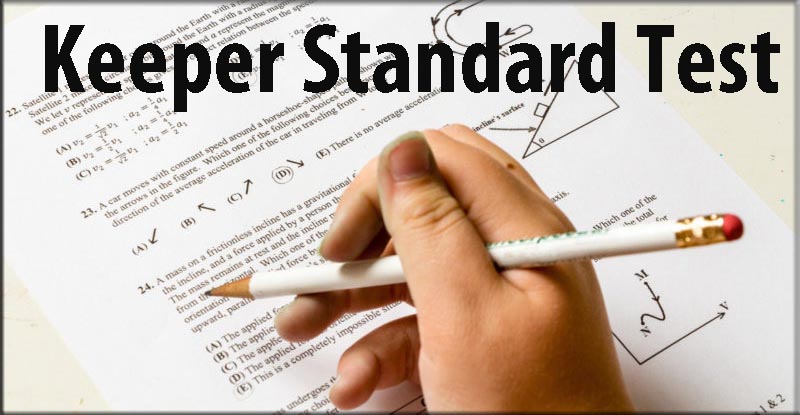The Keeper Standard Test (KST) is a structured assessment tool designed to evaluate the knowledge, skills and performance of professionals in a variety of professional fields. This essay explores the benefits, challenges and impacts of the Keeper Standard Test in different sectors. It focuses on its implementation, conceptualization and benefits.
In a world that is becoming increasingly competitive, it has become essential to have standardized assessment tools. The Keeper Standard Test is a powerful solution that provides a consistent, objective measurement of individual competences. This essay will explore the Keeper Standard Test and shed light on its design, practical applications, as well as broader implications.
Keeper Standard Test: Conceptual Basis
2.1 Definition and purpose
The Keeper Standard Test is a formalized framework for evaluating an individual’s competence in a particular field. Its main purpose is to create a standard benchmark that can be widely recognized and respected. This will ensure that individuals are meeting the required standards.
2.2 Historical context
In ancient China, civil service exams were used to select government officers. This concept has evolved over the centuries to become the modern standardized tests, such as the SAT and GRE. The Keeper Standard Test builds on this foundation by incorporating contemporary advances in assessment methods and technology.
The design and structure of the Keeper Standard Test
Core Components
The Keeper Standard Test is composed of several core components that are designed to evaluate an individual holistically.
- Knowledge Assessement This section assesses the theoretical understanding key concepts in the field.
- Practical Skill Evaluation This component measures the ability to apply theory in real-life scenarios.
- Analytical Skills This section measures your ability to solve problems effectively and analyze them.
- Communication skills and interpersonal skills: This section assesses communication abilities and teamwork capabilities.
3.2 Test formats
Keeper Standard Tests are available in different formats to suit various testing requirements and contexts.
- Multiple Choice Questions (MCQs). is widely used to assess knowledge due to its objectivity and easy scoring.
- Practical tasks: Hands on exercises that simulate real world challenges and allow for assessment of practical skills.
- Case Studies : Complex scenarios that demand analytical thinking and problem solving.
- Oral Exams: Assessments that focus on communication and the ability of knowledge to be articulated effectively.
3.3 Scoring Methods
The Keeper Standard Test is scored using a combination objective and subjective criteria. Automated systems ensure accuracy and efficiency when MCQs are used and for certain practical tasks. In case studies and oral examinations, evaluators are trained to use standard rubrics for fair and consistent assessments.
Implementation across Different Sectors
4.1 Education
The Keeper Standard Test is a vital tool in the educational field for evaluating the learning outcomes of students and ensuring quality education.
4.1.1 Education for K-12
The Keeper Standard Test is used in K-12 education to evaluate students’ mastery over core subjects, identify improvement areas, and guide the development of curriculum. It gives educators valuable insight into student performance and enables data-driven decision making to improve teaching strategies.
4.1.2 Higher education
The Keeper Standard Test is used in higher education for certification, admission, and placement. It helps universities to maintain high academic standards, and ensures graduates have the knowledge and skills they need to succeed in their fields.
4.2 Professional Certificate
Keeper Standard Tests are used by professional certification programs to verify the knowledge of those seeking certification. It is important to ensure that professionals who are certified meet industry standards, and can perform their role effectively.
4.2.1 Healthcare
Standardized testing is essential in healthcare for the certification of medical practitioners, nurses and other healthcare professionals. The Keeper Standard Test ensures that healthcare professionals possess the necessary competencies to maintain high standards in patient care and safety.
4.2.2 Information Technology
Certification programs in the rapidly changing field of Information Technology use the Keeper Standard Test as a tool to evaluate proficiency across a range of technical skills from programming languages to cyber security. This helps employers to identify qualified candidates, and professionals can advance their careers.
4.3 Job Search
Employers in a variety of industries use Keeper Standard Tests to help them identify the best candidates. This approach improves the hiring process because it provides objective data about candidate competencies. It also reduces biases and improves the overall quality.
Keeper Standard Test Benefits
5.1 Fairness and Objectivity
The Keeper Standard Test has the ability to assess individual competency in a fair and objective manner. It minimizes subjective biases by using standardized criteria and scoring systems.
5.2 Validity and Reliability
The Keeper Standard Test has been designed to be both valid and reliable. Validity measures how accurately the test assesses intended competencies. These qualities are ensured by rigorous test development processes that include pilot testing and statistical analysis.
5.3 Comprehensive Assessment
By incorporating multiple components–knowledge, practical skills, analytical abilities, and communication–the Keeper Standard Test offers a comprehensive evaluation of an individual’s capabilities. This holistic approach gives a better picture of competency compared to assessments that only focus on one dimension.
5.4 Benchmarking & Standardization
The Keeper Standard Test is a benchmark that can be used to measure competencies in different contexts. It allows for comparisons to be made between institutions, individuals and regions. This helps maintain high standards, while driving continuous improvement.
5.5 Improved Decision Making
Keeper Standard Test is a valuable tool for educators, employers and certification bodies. It provides data that can be used to make informed decisions. It supports strategic planning and targeted interventions by providing clear insight into strengths and weaknesses.
Critiques and Challenges
6.1 Test anxiety and performance pressure
Test anxiety and pressure to perform are two of the main criticisms leveled at standardized tests, including the Keeper Standard Test. Stress and anxiety can be caused by high-stakes tests, and this may affect performance.
6.2 Equity & Accessibility
It is difficult to ensure equity and accessibility when it comes to standardized tests. Test performance can be affected by factors such as socioeconomic status, language barrier, and disability, which raises concerns about fairness. To address these issues, ongoing efforts are needed to create inclusive tests and offer appropriate accommodations.
6.3 Teaching the Test
Teachers may be more focused on test preparation than on broader learning goals in educational settings. This phenomenon is known as “teaching for the test” and can limit the curriculum, and students’ chances to learn more and develop critical thinking.
6.4 Technological Barriers and Logistical Barriers
The administration of the Keeper Standard Test can be a logistical challenge, especially in remote and diverse locations. Some test takers may have difficulty accessing technology, including computers and the Internet. This can lead to alternative arrangements or support systems.
Technological Advancements and Future Directions
7.1 Computer Based Testing
The Keeper Standard Test has been revolutionized by the shift to computer-based testing. CBT has several advantages including enhanced security and increased efficiency. It also allows for interactive and adaptive elements.
7.2 Artificial Intelligence & Machine Learning
In standardized testing, artificial intelligence (AI), machine learning (ML) and other technologies are being increasingly integrated. AI can help in creating more complex test items, giving personalized feedback, and analysing test data to identify patterns and trends. These improvements have the potential of further improving the reliability, validity and fairness the Keeper Standard Test.
7.3 Online testing and Remote Proctoring
COVID-19, a pandemic that has been sweeping the world since 1999, has accelerated the adoption and use of online testing and remote proctoring solutions. These technologies enable individuals to take the Keeper Standard Test virtually anywhere. This increases accessibility and convenience. Future development will continue to focus on ensuring the integrity and safety of online testing.
Case Studies and Real-World Applications
8.1 Education Sector
8.1.1 Improving student outcomes
An urban large school district conducted a case study to demonstrate the impact the Keeper Standard Test has on student outcomes. The district implemented the test in a comprehensive assessment plan to identify student learning gaps, customize instruction and improve the overall performance of students on state exams.
8.1.2 Enhancing teacher effectiveness
In a second case study, an university used the Keeper Standard Test as a tool to assess the effectiveness of their teacher preparation program. The results were valuable feedback for program improvement, which ultimately led to better-prepared educators and higher student achievement.
8.2 Professional Certificate
8.2.1 Ensure Competency in Healthcare
As part of the certification process for nurses, a national healthcare organization adopted the Keeper Standard Test. The standard assessment ensured that nurses with certification had the clinical skills and knowledge necessary to improve patient care and safety.
8.2.2 Advancing IT Skills
Keeper Standard Test was adopted by a leading IT certification body to assess candidates’ competency in new technologies, such as cloud computing and cyber security. The comprehensive approach of the test gives employers confidence in certified professionals.
8.3 Job Search
8.3.1 Streamlining Hiring Processes
The Keeper Standard Test was integrated into the recruitment process of a multinational corporation for technical roles. The standard test helped streamline hiring by providing objective data about candidates’ skills. It also reduced time to hire and improved the quality of new employees.
8.3.2 Diversity and Inclusion
A second case study highlighted how the Keeper Standard Tests were used to promote diversity and inclusivity in hiring. The test’s focus on objective measures of competence helped minimize biases, and supported the recruitment of more diverse workers.
Ethical considerations and best practices
9.1 Equity and Fairness
To ensure fairness and equality in standardized testing, a commitment to improvement and inclusion is required. The best practices include regular bias analyses and providing accommodations for people with disabilities.
9.2 Transparency & Accountability
Transparency is key to maintaining the integrity and reliability of the Keeper Standard Test. This includes clear communication regarding test purposes, scoring criteria and processes as well as mechanisms that address concerns and appeals.
9.3 Data privacy and security
It is important to protect the privacy and security data of test takers. Adhering to privacy laws, implementing robust data protection measures and ensuring the secure storage and transmittal of test data is essential.
CONCLUSION
The Keeper Standard Test represents a significant advance in the field standardized assessment. The comprehensive and objective nature of the Keeper Standard Test provides invaluable insights into an individual’s competencies. This helps educational institutions, professional certification agencies, and employers make informed decisions. While there are challenges and criticisms, ongoing efforts to improve fairness, access, and technology integration promise to further enhance the effectiveness and impact the Keeper Standard Test.
In the future, we will see that the evolution of assessment methods and technologies is crucial in defining the landscape of standard testing. With its commitment to innovation and excellence, the Keeper Standard Test is well positioned to remain an important cornerstone in competency assessment for years to come.


